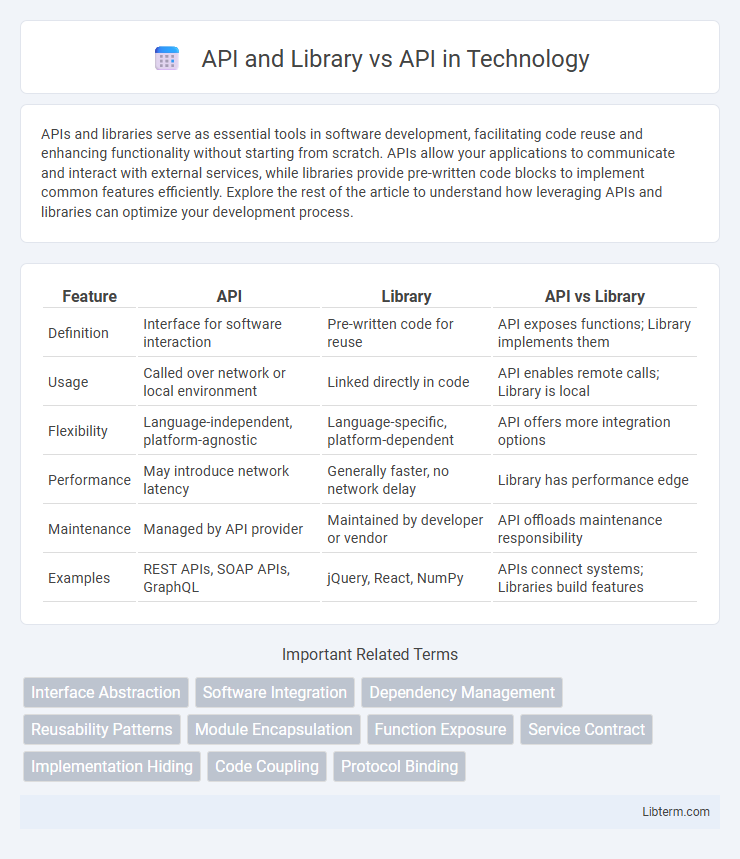APIs and libraries serve as essential tools in software development, facilitating code reuse and enhancing functionality without starting from scratch. APIs allow your applications to communicate and interact with external services, while libraries provide pre-written code blocks to implement common features efficiently. Explore the rest of the article to understand how leveraging APIs and libraries can optimize your development process.
Table of Comparison
| Feature | API | Library | API vs Library |
|---|---|---|---|
| Definition | Interface for software interaction | Pre-written code for reuse | API exposes functions; Library implements them |
| Usage | Called over network or local environment | Linked directly in code | API enables remote calls; Library is local |
| Flexibility | Language-independent, platform-agnostic | Language-specific, platform-dependent | API offers more integration options |
| Performance | May introduce network latency | Generally faster, no network delay | Library has performance edge |
| Maintenance | Managed by API provider | Maintained by developer or vendor | API offloads maintenance responsibility |
| Examples | REST APIs, SOAP APIs, GraphQL | jQuery, React, NumPy | APIs connect systems; Libraries build features |
Understanding APIs: Definitions and Core Concepts
APIs (Application Programming Interfaces) enable software systems to communicate by defining protocols and tools for building applications. Libraries are collections of pre-written code that developers integrate into their programs to perform specific tasks, serving as a resource rather than a communication interface. Understanding APIs involves recognizing them as contracts that specify how different software components interact, whereas libraries provide functional building blocks without enforcing interaction rules.
What is a Library? Key Functions Explained
A library is a collection of pre-written code, functions, and routines that developers use to perform specific tasks without writing code from scratch, streamlining software development. Key functions provided by a library include data manipulation, input/output processing, and system resource management, allowing efficient code reuse and modularity. Unlike an API, which defines the interface for communication between software components, a library contains the actual implementation of functionality that can be directly invoked by the developer.
API vs. Library: Fundamental Differences
APIs define protocols and tools for building software and enable communication between different software components. Libraries are collections of pre-written code that developers call upon to perform specific tasks within their applications. The fundamental difference lies in APIs serving as interfaces for interaction, while libraries provide reusable functionality through direct code inclusion.
How APIs Work: Communication and Integration
APIs function as intermediaries that enable communication between different software applications by defining protocols and data exchange formats. Libraries provide reusable code components accessible within the same application, while APIs facilitate integration across separate systems through standardized requests and responses. This communication framework allows developers to extend functionality, streamline workflows, and ensure seamless interoperability between diverse platforms.
The Role of Libraries in Software Development
Libraries serve as collections of pre-written code that developers can integrate into software projects to expedite development, enhance functionality, and ensure code reusability. Unlike APIs, which define the protocols for interaction between software components, libraries provide the actual implementations that developers call upon directly. Their crucial role in software development lies in abstracting complex operations into manageable functions, enabling faster innovation and more maintainable codebases.
Advantages of Using APIs in Modern Applications
APIs enable seamless integration between different software components, allowing modern applications to access external services and data efficiently. They promote modularity and scalability, reducing development time by leveraging existing functionality rather than building features from scratch like traditional libraries. This enhances interoperability and supports continuous innovation through easy updates and third-party service integration.
When to Use a Library Instead of an API
Choose a library instead of an API when you need direct access to pre-built functions and routines that can be integrated seamlessly into your application's codebase, offering immediate functionality and reducing development time. Libraries are ideal for tasks requiring in-process execution, such as data manipulation, graphics rendering, or mathematical computations, providing higher performance due to local function calls without network overhead. Opt for an API when the interaction requires remote service access, interoperability across different systems, or integration with third-party platforms that expose functionality via defined interfaces over the network.
Real-World Examples: API and Library Usage
APIs and libraries serve distinct roles in software development: an API defines a set of rules and protocols for interacting with software components, while a library offers reusable code to perform specific functions. For example, the Google Maps API enables developers to embed interactive maps into applications by sending requests and handling responses, whereas the jQuery library provides a collection of pre-written JavaScript functions for easy DOM manipulation. In real-world scenarios, APIs like Twitter's REST API allow apps to access and post tweets programmatically, while libraries such as React offer pre-built UI components to streamline frontend development.
Security Considerations: API vs. Library Integration
API integration offers enhanced security by enforcing strict access controls and monitoring data exchanges between systems, reducing exposure to vulnerabilities. Libraries, embedded directly in the application code, carry risks of introducing insecure dependencies or outdated components that can be exploited. Implementing robust authentication, encryption, and regular security audits is critical when using APIs to mitigate threats compared to libraries' internal integration risks.
Choosing the Right Approach: API, Library, or Both?
Choosing between an API and a library depends on the level of abstraction and control required in software development. APIs provide standardized interfaces for communication between different software components, enabling flexibility and interoperability, while libraries offer bundled pre-written code that developers can call directly for specific functionalities. Combining both can optimize project outcomes by leveraging APIs for modularity and libraries for efficient implementation of complex tasks.
API and Library Infographic

 libterm.com
libterm.com